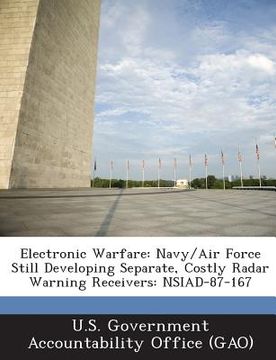Share
Electronic Warfare: Navy/Air Force Still Developing Separate, Costly Radar Warning Receivers: Nsiad-87-167 (in English)
U. S. Government Accountability Office ( ; U. S. Government Accountability Office ( (Author)
·
Bibliogov
· Paperback
Electronic Warfare: Navy/Air Force Still Developing Separate, Costly Radar Warning Receivers: Nsiad-87-167 (in English) - U. S. Government Accountability Office ( ; U. S. Government Accountability Office (
$ 13.26
$ 15.75
You save: $ 2.49
Choose the list to add your product or create one New List
✓ Product added successfully to the Wishlist.
Go to My WishlistsIt will be shipped from our warehouse between
Wednesday, July 31 and
Thursday, August 01.
You will receive it anywhere in United States between 1 and 3 business days after shipment.
Synopsis "Electronic Warfare: Navy/Air Force Still Developing Separate, Costly Radar Warning Receivers: Nsiad-87-167 (in English)"
GAO reviewed Air Force and Navy radar warning receiver (RWR) programs, focusing on the: (1) Department of Defense's (DOD) lack of response to prior recommendations for achieving commonality in RWR acquisition programs; and (2) Air Force's and Navy's continued acquisition of separate receivers and the adverse effects resulting from this acquisition. GAO found that: (1) DOD did not implement the recommendations for overcoming obstacles to the merger of Air Force and Navy RWR programs; (2) the Air Force RWR improvement program will cost an estimated $500 million; (3) the Navy's RWR improvement program was estimated to cost over $1.3 billion; (4) both the Air Force and Navy are acquiring nine different receivers for existing tactical aircraft, at an estimated cost of over $6.6 billion; and (5) none of the receivers are common to both Air Force and Navy aircraft, and seven of them entered development or production since GAO and Congress made their merger recommendations. GAO noted that the: (1) main problem in achieving commonality appears to be each service's belief that its system concept is best and the constant updating of unique systems; (2) services' main argument against changing to a common system is the cost involved in the aircraft wiring adjustments to accommodate a replacement RWR; and (3) services did not include the cost benefits of commonality in their analyses of RWR programs. GAO also found that, because the Air Force and Navy concurrently tested and produced receivers, production began before operational testing revealed serious deficiencies with the receivers.
- 0% (0)
- 0% (0)
- 0% (0)
- 0% (0)
- 0% (0)
All books in our catalog are Original.
The book is written in English.
The binding of this edition is Paperback.
✓ Producto agregado correctamente al carro, Ir a Pagar.

